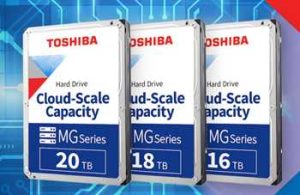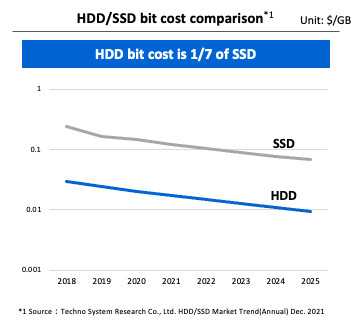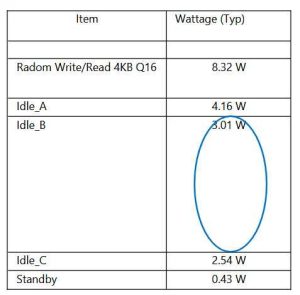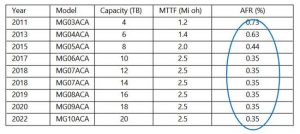From Toshiba, Sustainable Future for Storage
Look at how HDD technology is advancing to reduce power consumed for storage and consider other ways that HDDs can help comply with environmental goals.
This is a Press Release edited by StorageNewsletter.com on July 3, 2023 at 2:02 pmBy Rainer W. Kaese, senior manager business development, storage products, Toshiba Electronics Europe GmbH
Maximizing storage and performance
while minimizing power consumption and environmental impact
Storage is essential to so many aspects of our modern world, as is protecting the environment. Yet, the 2 needs often seem to be ‘at odds’ with the majority of cloud data being held on HDDs that many consider to be power-hungry.
In this article, we will look at how HDD technology is advancing to reduce the power consumed for storage and consider other ways that HDDs can help us comply with our environmental goals.
Why use HDDs for cloud?
Data is valuable these days, so storage and retention is an important consideration for this 21st-century ‘currency’. The 3 primary options for storage are tape, HDDs and SSDs – each with different attributes.
Tape is primarily a backup media. It is very reliable and low cost, but access is far too slow for it to be considered as a cloud storage medium. This leaves HDDs and SSDs, both of which are viable considerations for cloud storage from a performance perspective.
While there are differences in power consumption and speed (SSD is faster and lower power), the biggest gap between the 2 technologies is cost.
Figure 1: HDDs 7x cheaper in terms of $/GB
When we look at the cost per unit storage, we first notice that the bit cost of HDDs is one-seventh that of SSDs. Equally interesting is that both costs are continuing to fall at a similar rate so, based on current projections, there is no expectation that SSD will become lower cost than HDD in the short-to-medium term.
With the scale of cloud storage, cost is a primary consideration and, for this reason, the vast majority of cloud storage is based on HDDs. As a direct comparison1, there were 88 million 3.5”/7,200rpm enterprise HDDs shipped in 2022 (a total of 1,021EB) while 66 million enterprise SSDs shipped for a total capacity of 175EB.
HDD power consumption reduces through innovation
With the scale of cloud storage, the energy consumption of HDDs is a significant consideration. The industry thinks in terms of watts per terabyte (W/TB) as this is a good measure of how much energy is needed globally to store all of the data in the cloud.
This measure also reflects the fact that to spin platters will always take a finite amount of energy – an unavoidable attribute of HDDs. So, while the industry continues to seek efficiencies in power consumed, in parallel, they are increasing HDD capacity while ensuring power consumed does not rise.
Figure 2: W/TB figures have dropped five-fold in decade
Back in 2011, a 4TB HDD (MG03 series) consumed around 10.5W – considered ‘state-of-the-art’ at that time – consuming 2.6W/TB. As innovation continued, by 2017 the capacity had increased 2.5x while power consumption remained almost constant (10.6W) so the W/TB had more than halved.
In fact, 2017 was a pivotal year for Toshiba HDDs. Faced with a need to use thinner platters to increase capacity, the air that filled the drives caused challenges with ‘fluttering’ during rotation. The air was replaced with helium which removed this issue and, as a thinner gas, the helium caused less friction on the platters. This is reflected in a 2.8W reduction in the overall HDD power consumption, as the motor has to work less hard.
So, through capacity increases, incorporation of helium and other innovations, the W/TB of a typical enterprise HDD has dropped 5x from 2.6 to 0.5W/TB, which will impact the energy needed to power cloud storage. The 2022 release of the 20TB MG10ACA continued the improvement with an extra 2TB of capacity, although active power only increased by 1W.
How use cases impact power consumption
Inherent within HDDs are further power-saving opportunities through the incorporation of idle and standby modes. If we consider an 18TB MG09 HDD, the operating power is around 8.3W when the platters are spinning, and the heads are moving to randomly read and write data. However, there are 3 ‘idle’ modes and a standby mode.
Figure 3: Idle modes offer opportunities for future power saving
In standby mode, the power consumed reduces to 0.43W, but this involves stopping the platters from rotating. While this is attractive from a consumption perspective, it can take up to 20s to spin the platters and be able to RW data. Clearly, this is not viable for online storage.
The idle modes variously switch off parts of the magnetics and/or electronics while the spindle continues to rotate. In these modes, the ‘wake up’ time is between 1.2. and 0.3s. However, with storage schemes such as RAID and SDS, there is frequent access even when the drive appears to be idle. This, therefore, precludes the use of these idle modes for power saving for now.
Upgrade to improve
As HDD reliability is excellent, failure rated have dropped significantly. Therefore, there is a huge installed base of HDDs with the 6Gb SATA interface that have been installed since 2010. However, as these are older technology, their W/TB figures are significantly higher than modern higher capacity HDDs.
As the interface and form factor is identical, it is a relatively easy exercise to simply swap the older drives for newer versions. In doing so, data center operators will benefit from more storage in the same space and power consumption will, at worst, remain the same. If moving to helium-filled HDDs, then the benefit will be greater as a up to 30% power saving can be anticipated.
HDD life cycle
One of the most sustainable ways to use HDDs is to use then for longer – 5 years or even more. This is much more possible now as annual failure rates (AFRs) have dropped by 50% (0.73% to 0.35%) in the past decade.
Figure 4: Higher reliability (MTTF) leading to lower AFRs.
Considering sustainability, remember that every HDD is up to 1kg of metal and other components/materials. This is a valuable resource of aluminum and copper that can be shredded and recycled when the HDD reaches end of life. In future, as resources become more scarce (and number of to be recycles HDDs will reach a significant scale), removing and re-using the rare-earth magnets is a potential sustainability ‘win’.
Latest technology

The latest HDD from Toshiba is the 20TB MG10ACA, available as 12Gb SAS or 6Gb SATA. The 3.5” device incorporates multiple shock and rotational vibration (RV) sensors for use in multi-bay systems. 10-platter and microwave assisted magnetic recording (MAMR) technologies increase the storage density to 20TB. The HDDs of the MG10 series offer a reliability of 2.5 million hours MTTF equal to an AFR of 0.35% within a warranty time of 5 years at a rated workload of 550TB/year.
Summary
HDDs are the best storage technology choice, primarily due to their low cost and high capacity. However, with their large-scale deployment, the industry is paying attention to their power consumption and sustainable use.
Innovation has allowed the W/TB figures to fall 5x in a decade and the introduction of helium in 2017 has dropped power consumption by 30%. In future, adapting RAID and SDS storage schemes may allow the use of idle modes (which exist today) to achieve further reductions.
Modern HDDs last longer and consume similar power levels to earlier generations. This allows them, and the associated power supplies, to be used for longer – often more than 5 years.
1 – Source: TEE research, TEE estimates, Gartner 4Q22 update
2 – Source: TEE product specs, TEE estimates, Gartner 4Q22 update
3 – Source: TEE product specs, TEE estimates, Gartner 4Q22 update

















 Subscribe to our free daily newsletter
Subscribe to our free daily newsletter

